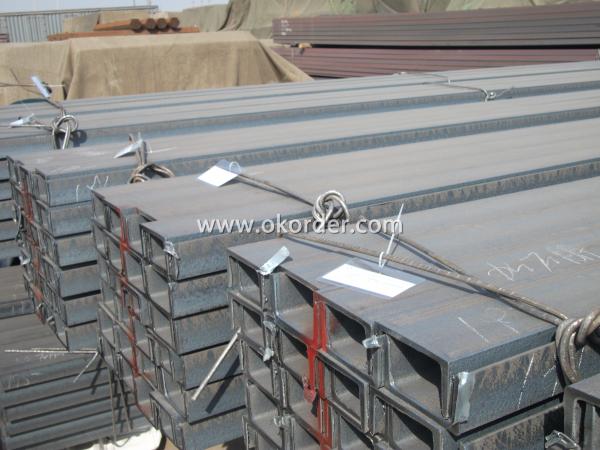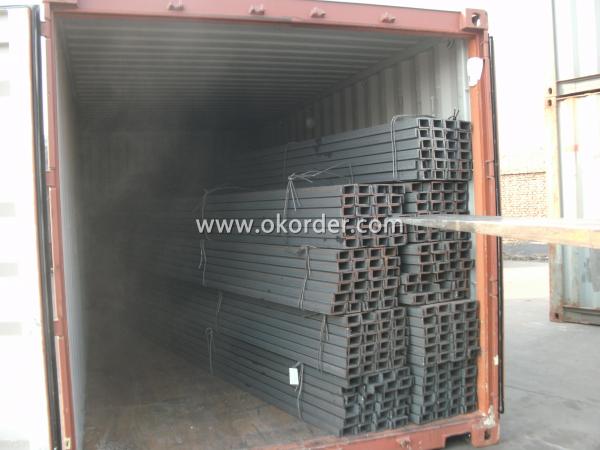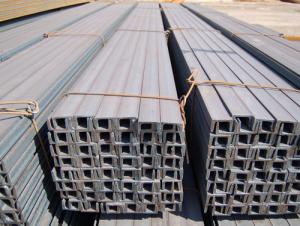UPN U CHANNEL
- Loading Port:
- China Main Port
- Payment Terms:
- TT OR LC
- Min Order Qty:
- -
- Supply Capability:
- -
OKorder Service Pledge
OKorder Financial Service
You Might Also Like
Channel Steel Details:
| Minimum Order Quantity: | 25 | Unit: | m.t. | Loading Port: | Xingang Port |
| Supply Ability: | 80000MTS/YEAR | Payment Terms: | TT or LC |
Product Description:
Specifications of Channel Steel:
| Original Place | Tangshan, China | Brand Name | Bridge |
| Standard | GB707-88, EN100025, JIS G3192, DIN 1026 | ||
| Sizes | 50mm to 300mm | ||
| Sales Volume/Year | 3000MT | ||
| Main Market | Middle East, Africa, Southeast As | ||
1.We are able to provide channel steel of top quality at attractive price.
2.Our products of channel steel have passed ISO9001:2008 Quality Management System Certification.
3. The section of JIS Standard Channel Steel are as followings in the table.
| JIS U CHANNEL | Standard h | Sectional b | Dimension s | t | Mass: Kg/m |
| (mm) | (mm) | (mm) | (mm) | ||
| 50x25 | 50 | 25 | 3.0 | 6.00 | 2.37 |
| 75X40 | 75 | 40 | 3.8 | 7.00 | 5.30 |
| 75X40 | 75 | 40 | 4.0 | 7.00 | 5.60 |
| 75X40 | 75 | 40 | 4.5 | 7.00 | 5.85 |
| 75X40 | 75 | 40 | 5.0 | 7.00 | 6.92 |
| 100X50 | 100 | 50 | 3.8 | 6.00 | 7.30 |
| 100X50 | 100 | 50 | 4.2 | 6.00 | 8.03 |
| 100X50 | 100 | 50 | 4.5 | 7.50 | 8.97 |
| 100X50 | 100 | 50 | 5.0 | 7.50 | 9.36 |
| 125X65 | 125 | 65 | 5.2 | 6.80 | 11.66 |
| 125X65 | 125 | 65 | 5.3 | 6.80 | 12.17 |
| 125X65 | 125 | 65 | 5.5 | 8.00 | 12.91 |
| 125X65 | 125 | 65 | 6.0 | 8.00 | 13.40 |
| 150x75 | 150 | 75 | 5.5 | 7.30 | 14.66 |
| 150x75 | 150 | 75 | 5.7 | 10.00 | 16.71 |
| 150x75 | 150 | 75 | 6.0 | 10.00 | 17.90 |
| 150x75 | 150 | 75 | 6.5 | 10.00 | 18.60 |
4. Chemical Compostion of JIS Standard Channel Steel
| Grade | Element(%) | |||
| C | Mn | P | S | |
| SS330 | -- | -- | ≦0.050 | ≦0.050 |
| SS400 | ||||
| SS490 | ||||
| SS540 | ≦0.30 | ≦1.60 | ≦0.040 | ≦0.040 |
Usage/Applications of Channel Steel:
Channel Steel is usually used for building structure, vehicle manufacturing and other industrial structure and often used with i beam.
In details, the channel steel belongs to carbon structural steel which is applied to in the field of construction and machinery. The channel steel is usually used for arch-itechtural structure, and they could be welded in order to support or hang a vari-ety of facilities. They are also usually used in combination with I beam. Generally,the channel steel must possess perfect welding property, riveting property and mechanical property and so on.
Package & Delivery of Channel Steel:
The steel u channel will be packed in bundle with steel wire at each end of every bundle and color marking in order to help the customer to recognize his goods more easily at sight.
And steel u channel could be loaded into 20ft or 40ft container, or by bulk cargo. If the weight of each bundle reaches less than 3.5 mt, the loading by break bulk cargo should be choosed. When the weight of each bundle reaches less than 3mt, the loading by container should be choosed.
As for the transportaion from mill to loading port, the truck will be usually used. And the maximum quantity for each truck is 40mt.
All in all, we could do in accordance with customer's request.


Production Flow of Channel Steel:
1.The steel billet shall be heated in the high temperature furnace.
2. The heated steel billet shall be rolled five to nine times with the aim of shaping the general figure of steel u channel.
3. The rolled steel u channel should be put onto the cooling bed to make the temperature low.
4. The steel u channel should be straighted on the straightener.
5. The straighted steel u channel will be cut into meters by saw, as per customer's requirements.
- Q:How do steel channels compare to other structural shapes?
- Steel channels are a structural shape that is versatile and widely used, offering various advantages compared to other shapes. One of the main benefits of steel channels is their high ratio of strength to weight. Their shape provides excellent support and load-bearing capacity, enabling the construction of strong and durable structures. In contrast to I-beams or angles, steel channels have a unique cross-section in the shape of a C, which provides greater resistance to bending. This makes them particularly suitable for applications where bending or torsional forces are present, ensuring the stability and integrity of the structure. Furthermore, steel channels come in a wide range of sizes and configurations, making them highly adaptable to different construction needs. They can be easily customized and cut to specific lengths, allowing for precise installation and minimizing waste. This versatility makes steel channels a popular choice in industries such as construction, manufacturing, and engineering. Another advantage of steel channels is their cost-effectiveness. Steel is a comparatively affordable material, and using steel channels efficiently in construction projects can optimize costs without compromising structural integrity. Additionally, steel channels have excellent corrosion resistance, extending their lifespan and reducing maintenance and replacement expenses. To summarize, steel channels offer numerous advantages over other structural shapes. Their high strength-to-weight ratio, resistance to bending, adaptability, and cost-effectiveness make them a reliable choice for various construction applications.
- Q:What are the load-bearing capabilities of steel channels?
- The load-bearing abilities of steel channels vary depending on several factors like dimensions, material grade, and the specific application at hand. Steel channels are designed to offer structural support and are commonly utilized in construction and engineering projects. The shape and size of a steel channel significantly impact its load-bearing capacity. The channel's depth, width, and thickness determine its overall strength and ability to endure loads. Additionally, the material grade of the steel channel plays a vital role in determining its load-bearing capabilities. Generally, higher grades of steel possess greater tensile and yield strengths, enabling them to support heavier loads. Engineers typically rely on industry standards and reference tables to precisely determine the load-bearing capabilities of a steel channel. These resources provide guidance on the safe working loads for different sizes and grades of steel channels. When calculating the maximum load a steel channel can bear, engineers also consider factors like the type of loading (e.g., static or dynamic), the support conditions (e.g., fixed or pinned), and the required safety factor. It is important to acknowledge that factors such as the quality of fabrication, the presence of defects or damage, and the overall structural design can also influence load-bearing capabilities. Therefore, consulting a qualified engineer or referring to appropriate design codes and regulations is crucial when determining the load-bearing capabilities of steel channels for a specific application.
- Q:How do steel channels perform in high-humidity environments?
- Steel channels can perform well in high-humidity environments, but their performance can be affected depending on the specific conditions. Steel is a durable and corrosion-resistant material, making it suitable for use in humid environments. However, prolonged exposure to high humidity, especially in the presence of certain corrosive substances, can lead to the formation of rust and degradation of the steel channels over time. To mitigate the effects of high humidity, steel channels can be coated with protective finishes or treated with corrosion inhibitors. These measures help to create a barrier between the steel and the surrounding moisture, preventing or delaying the onset of rust formation. Additionally, proper ventilation and moisture control in the environment can also help minimize the impact of high humidity on steel channels. Adequate air circulation and the use of dehumidifiers can help reduce the moisture content in the air, thereby decreasing the chances of rust formation. Regular maintenance and inspections are crucial to identify and address any signs of corrosion early on. Prompt cleaning and reapplication of protective coatings, if necessary, can help extend the lifespan and performance of steel channels in high-humidity environments. Overall, while steel channels can withstand high humidity to a certain extent, it is important to take appropriate measures to protect them from excessive moisture and corrosion in order to ensure their long-term performance and durability.
- Q:What are the recommended safety precautions when working with steel channels?
- When working with steel channels, it is important to follow some recommended safety precautions. These include wearing personal protective equipment such as safety glasses, gloves, and steel-toed boots to protect against potential injuries from sharp edges or falling objects. Additionally, using proper lifting techniques and equipment to handle heavy steel channels can prevent strains and back injuries. It is also crucial to ensure a stable and secure work environment by securing the channels properly, using appropriate support structures, and working on a level surface. Regular inspection and maintenance of tools and equipment, as well as being aware of potential hazards and following safe work practices, are essential for a safe working environment when dealing with steel channels.
- Q:Steel arc bending machine can provide the best what? ` type details
- Specify the requirements for bending accuracy and whether there is any curvature change requirement. Does this decision require numerical control equipment?.
- Q:Hello, I have a question to ask you, do a steel hoop, the outer diameter of 1688MM, with 8# steel roll, want to ask next to the long material, 8# channel 43, formula I for (1688-43) *3.14159=5168mm, this material, placed above the rolling machine to roll how, outside diameter it is more than 1688 Oh, I would like to ask, feeding formula should start rolling steel...Is it possible to stretch the roll with a profile bending machine? Can you recommend 1-2 units? It's best to have the approximate price. I'd like to consider whether I can buy one. Thank you
- Steel hoop, the outer diameter of 1688MM, with 8# steel roll, theoretical calculation formula for *3.14159=5168mm (1688-43), but this material, placed above the rolling machine to roll bending process, due to tension phenomenon, so roll diameter to be bigger, and the inner groove is also just outside bend channel rolling material should be the theoretical length minus extension length, the best use of section bending machine bending machine die roll, or
- Q:Can steel channels be used in historical restoration projects?
- Yes, steel channels can be used in historical restoration projects. They can provide structural support and reinforcement, especially in cases where the original materials are deteriorated or insufficient. However, it is important to ensure that the use of steel channels is done in a way that preserves the historical integrity and appearance of the building or structure.
- Q:What are the applications of steel channels?
- Steel channels have a wide range of applications in various industries. They are commonly used as structural components in buildings and bridges, providing support and reinforcement. Steel channels are also utilized in the manufacturing of machinery and equipment, such as conveyor systems and material handling devices. Additionally, they are essential in the construction of vehicles, including cars, trucks, and ships, due to their strength and durability. Overall, steel channels play a crucial role in numerous sectors where strength, stability, and load-bearing capabilities are required.
- Q:How do steel channels compare to I-beams?
- Steel channels and I-beams are both structural steel shapes that are commonly used in construction and engineering applications. While they have some similarities, they also have distinct differences. One key difference between steel channels and I-beams is their shape. Steel channels have a C-shaped cross-section, with two flanges on either side and a web connecting them. This design provides good structural support and resistance against bending. On the other hand, I-beams have an I-shaped cross-section, with two flanges and a central web. This design distributes the load evenly across the beam's top and bottom flanges, making it highly efficient for carrying heavy loads and resisting bending and deflection. Another difference is their weight-bearing capacity. I-beams are known for their high strength-to-weight ratio, making them capable of carrying larger loads over longer spans. Steel channels, while still strong, are typically used for lighter applications or as secondary structural components. Cost can also be a factor when comparing steel channels and I-beams. Generally, steel channels tend to be more cost-effective compared to I-beams due to their simpler manufacturing process and smaller size. However, the specific cost will depend on the size, length, and quality of the materials. In terms of versatility, both steel channels and I-beams offer a wide range of applications. Steel channels are commonly used for framing, support structures, and bracing in construction projects. They can also be used as lintels or purlins. I-beams, on the other hand, are widely used in the construction of bridges, buildings, and large-scale infrastructure projects where heavy loads and long spans are required. In conclusion, steel channels and I-beams have different shapes, weight-bearing capacities, costs, and applications. Steel channels are typically more cost-effective and suitable for lighter applications, while I-beams offer superior strength and are better suited for heavy loads and longer spans. Choosing between the two will depend on the specific requirements of the project and the desired balance between strength, cost, and design.
- Q:How are steel channels protected against rust during construction?
- Steel channels are typically protected against rust during construction by applying a corrosion-resistant coating such as galvanization or paint. These protective coatings act as a barrier, preventing moisture and oxygen from reaching the steel surface, thus inhibiting the formation of rust. Additionally, proper storage and handling practices are followed to minimize exposure to moisture and ensure the integrity of the protective coatings.
1. Manufacturer Overview |
|
|---|---|
| Location | |
| Year Established | |
| Annual Output Value | |
| Main Markets | |
| Company Certifications | |
2. Manufacturer Certificates |
|
|---|---|
| a) Certification Name | |
| Range | |
| Reference | |
| Validity Period | |
3. Manufacturer Capability |
|
|---|---|
| a)Trade Capacity | |
| Nearest Port | |
| Export Percentage | |
| No.of Employees in Trade Department | |
| Language Spoken: | |
| b)Factory Information | |
| Factory Size: | |
| No. of Production Lines | |
| Contract Manufacturing | |
| Product Price Range | |
Send your message to us
UPN U CHANNEL
- Loading Port:
- China Main Port
- Payment Terms:
- TT OR LC
- Min Order Qty:
- -
- Supply Capability:
- -
OKorder Service Pledge
OKorder Financial Service
Similar products
New products
Hot products
Related keywords





























